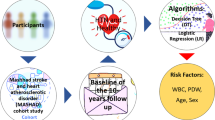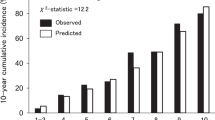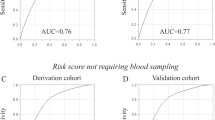Abstract
Although several studies have shown that high WBC count is a risk factor for hypertension, the relationship between WBC count and the incidence of hypertension in Japanese is poorly understood, as are the effects of WBC components on that relationship. Our objective was to verify in a Japanese population whether WBC or differential WBC count predicts hypertension incidence. A total of 9,383 initially hypertension-free subjects (3,356 men and 6,027 women), whose WBC counts were within the normal range (3,000 to <10,000 cells/mm3), were followed from 1965 to 2004. During this 40-year follow-up, 4,606 subjects developed hypertension. After adjusting for conventional risk factors, including smoking status, we found that elevated WBC count was associated with hypertension incidence in a Cox regression model with both fixed and time-varying covariates for women. For men, elevated WBC count was a significant risk factor for hypertension only in the time-varying Cox-regression covariate. We also observed a significant association between increased neutrophil count and hypertension incidence among women. In a fully adjusted model, the relative risks of hypertension incidence, from the lowest to the highest quartiles of neutrophil count, were 1.00, 1.18, 1.28, and 1.22 in women (p for trend <0.001). In conclusion, elevated WBC count predicted an increased incidence of hypertension in Japanese, especially among females. Moreover, neutrophils were the major WBC component contributing to the increased risk.
Similar content being viewed by others
Article PDF
References
Margolis KL, Manson JE, Greenland P, et al: Leukocyte count as a predictor of cardiovascular events and mortality in postmenopausal women: the Women's Health Initiative Observational Study. Arch Intern Med 2005; 165: 500–508.
Zalokar J, Richard JL, Claude JR : Leukocyte count, smoking, and myocardial infarction. N Engl J Med 1981; 304: 465–468.
Brown DW, Ford ES, Giles WH, Croft JB, Balluz LS, Mokdad AH : Associations between white blood cell count and risk for cerebrovascular disease mortality: NHANES II Mortality Study, 1976–1992. Ann Epidemiol 2004; 14: 425–430.
Lee CD, Folsom AR, Nieto FJ, Chambless LE, Shahar E, Wolfe DA : White blood cell count and incidence of coronary heart disease and ischemic stroke and mortality from cardiovascular disease in African-American and White men and women: Atherosclerosis Risk in Communities Study. Am J Epidemiol 2001; 154: 758–764.
Sweetnam PM, Thomas HF, Yarnell JWG, Baker IA, Elwood PC : Total and differential leukocyte counts as predictors of ischemic heart disease: the Caerphilly and Speedwell Studies. Am J Epidemiol 1997; 145: 416–421.
Danesh J, Collins R, Appleby P, Peto R : Association of fibrinogen, C-reactive protein, albumin, or leukocyte count with coronary heart disease: meta-analyses of prospective studies. JAMA 1998; 279: 1477–1482.
Danesh J, Wheeler JG, Hirschfield GM, et al: C-reactive protein and other circulating markers of inflammation in the prediction of coronary heart disease. N Engl J Med 2004; 350: 1387–1397.
Cushman M, Arnold AM, Psaty BM, et al: C-reactive protein and the 10-year incidence of coronary heart disease in older men and women: the cardiovascular health study. Circulation 2005; 112: 25–31.
Shankar A, Klein BE, Klein R : Relationship between white blood cell count and incident hypertension. Am J Hypertens 2004; 17: 233–239.
Nakanishi N, Sato M, Shirai K, Suzuki K, Tatara K : White blood cell count as a risk factor for hypertension; a study of Japanese male office workers. J Hypertens 2002; 20: 851–857.
Gillum RF, Mussolino ME : White blood cell count and hypertension incidence: The NHANES I Epidemiologic Follow-up Study. J Clin Epidemiol 1994; 47: 911–919.
Friedman GD, Selby JV, Quesenberry CP Jr : The leukocyte count: a predictor of hypertension. J Clin Epidemiol 1990; 43: 907–911.
Sesso HD, Buring JE, Rifai N, Blake GJ, Gaziano JM, Ridker PM : C-reactive protein and the risk of developing hypertension. JAMA 2003; 290: 2945–2951.
Bermudez EA, Rifai N, Buring J, Manson JE, Ridker PM : Interrelationships among circulating interleukin-6, C-reactive protein, and traditional cardiovascular risk factors in women. Arterioscler Thromb Vasc Biol 2002; 22: 1668–1673.
Smedly LA, Tonnesen MG, Sandhause RA, et al: Neutrophil-mediated injury to endothelial cells. Enhancement by endotoxin and essential role of neutrophil elastase. J Clin Invest 1986; 77: 1233–1243.
Weiss SJ : Tissue destruction by neutrophils. N Engl J Med 1989; 320: 365–376.
Lassègue B, Clempus RE : Vascular NAD(P)H oxidase: specific features, expression and regulation. Am J Physiol Regul Integr Comp Physiol 2003; 285: R277–297.
Yasunari K, Maeda K, Nakamura M, Watanabe T, Yoshikawa J : Benidipine, a long-acting calcium channel blocker, inhibits oxidative stress in polymorphonuclear cells in patients with essential hypertension. Hypertens Res 2005; 28: 107–112.
Taniyama Y, Griendling KK : Reactive oxygen species in the vasculature: molecular and cellular mechanisms. Hypertension 2003; 42: 1075–1081.
Griendling KK, FitzGerald GA : Oxidative stress and cardiovascular injury. Part II: Animal and human studies. Circulation 2003; 108: 2034–2040.
Sela S, Mazor R, Amsalam M, Yagil C, Yagil Y, Kristal B : Primed polymorphonuclear leukocytes, oxidative stress, and inflammation antecede hypertension in the Sabra Rat. Hypertension 2004; 44: 764–769.
Schmid-Schönbein GW, Seiffge D, DeLano FA, Shen K, Zweifach BW : Leukocyte counts and activation in spontaneously hypertensive and normotensive rats. Hypertension 1991; 17: 323–330.
Akahoshi M, Soda M, Nakashima E, Shimaoka K, Seto S, Yano K : Effects of menopause on trends of serum cholesterol, blood pressure, and body mass index. Circulation 1996; 94: 61–66.
Yamada M, Wong FL, Fujiwara S, Akahoshi M, Suzuki G : Noncancer disease incidence in atomic bomb survivors, 1958–1998. Radiat Res 2004; 16: 622–632.
WHO Study Group: Diabetes Mellitus. Geneva, World Health Organization, Technical Report Series no 727, 1985.
Kannel WB, Sorlie P : Some health benefits of physical activity: the Framingham Study. Arch Intern Med 1979; 139: 857–861.
Wheeler JG, Mussolino ME, Gillum RF, Danesh J : Associations between differential leukocyte count and incident coronary heart disease: 1764 incident cases from seven prospective studies of 30 374 individuals. Eur Heart J 2004; 25: 1287–1292.
Ueshima H : Explanation for the Japanese paradox: prevention of increase in coronary heart disease and reduction in stroke. J Atheroscler Thromb 2007; 14: 278–286.
Sunyer J, Muñoz A, Peng Y, et al: Longitudinal relation between smoking and white blood cells. Am J Epidemiol 1996; 144: 734–741.
Yoshiike N, Seino F, Tajima S, et al: Twenty-year changes in the prevalence of overweight in Japanese adults: the National Nutrition Survey 1976–95. Obes Rev 2002; 3: 183–190.
Nagasawa N, Tamakoshi K, Yatsuya H, et al: Association of white blood cell count and clustered components of metabolic syndrome in Japanese men. Circ J 2004; 68: 892–897.
Ross R : Atherosclerosis — an inflammatory disease. N Engl J Med 1999; 340: 115–126.
Pearson TA, Mensah GA, Alexander RW, et al: Markers of inflammation and cardiovascular disease: application to clinical and public health practice: a statement for healthcare professionals from the Centers for Disease Control and Prevention and the American Heart Association. Circulation 2003; 107: 499–511.
Trayhurn P, Wood IS : Adipokines: inflammation and the pleiotropic role of white adipose tissue. Br J Nutr 2004; 92: 347–355.
Straczkowski M, Dzienis-Straczkowska S, Stêpieñ A, Kowalska I, Szelachowska M, Kinalska I : Plasma interleukin-8 concentrations are increased in obese subjects and related to fat mass and tumor necrosis factor-α system. J Clin Endocrinol Metab 2002; 87: 4602–4606.
Herder C, Haastert B, Müller-Scholze S, et al: Association of systemic chemokine concentrations with impaired glucose tolerance and type 2 diabetes: results from the Cooperative Health Research in the Region of Augsburg Survey S4 (KORA S4). Diabetes 2005; 54 (Suppl 2): S11–S17.
Boekholdt SM, Peters RJ, Hack CE, et al: IL-8 plasma concentrations and the risk of future coronary artery disease in apparently healthy men and women: the EPIC-Norfolk prospective population study. Arterioscler Thromb Vasc Biol 2004; 24: 1503–1508.
Oppenheim JJ, Zachariae CO, Mukaida N, Matsushima K : Properties of the novel proinflammatory supergene “intercrine” cytokine family. Annu Rev Immunol 1991; 9: 617–648.
Baggiolini M, Dewald B, Moser B : Interleukin-8 and related chemotactic cytokines-CXC and CC chemokines. Adv Immunol 1994; 55: 97–179.
Mügge A, Lopez JA : Do leukocytes have a role in hypertension? Hypertension 1991; 17: 331–333.
The fifth report of the Joint National Committee on Detection, Evaluation, and Treatment of High Blood Pressure (JNC V). Arch Intern Med 1993; 153: 154–183.
1999 World Health Organization– International Society of Hypertension Guidelines for the Management of Hypertension. Guidelines Subcommittee. J Hypertens 1999; 17: 151–183.
Nakamura K, Okamura T, Hayakawa T, et al: The proportion of individuals with alcohol-induced hypertension among total hypertensives in a general Japanese population: NIPPON DATA 90. Hypertens Res 2007; 30: 663–668.
Kawano Y, Ando K, Matsuura H, Tsuchihashi T, Fujita T, Ueshima H : Report of the Working Group for Dietary Salt Reduction of the Japanese Society of Hypertension: (1) Rationale for salt restriction and salt-restriction target level for the management of hypertension. Hypertens Res 2007; 30: 879–886.
Japanese Society of Hypertension: Japanese Society of Hypertension Guidelines for the Management of Hypertension (JSH 2004). Hypertens Res 2006; 29 ( Suppl): S1–S105.
Author information
Authors and Affiliations
Corresponding author
Rights and permissions
About this article
Cite this article
Tatsukawa, Y., Hsu, WL., Yamada, M. et al. White Blood Cell Count, Especially Neutrophil Count, as a Predictor of Hypertension in a Japanese Population. Hypertens Res 31, 1391–1397 (2008). https://doi.org/10.1291/hypres.31.1391
Received:
Accepted:
Issue date:
DOI: https://doi.org/10.1291/hypres.31.1391
Keywords
This article is cited by
-
NETs: an extracellular DNA network structure with implication for cardiovascular disease and cancer
Hypertension Research (2024)
-
A link between white blood cell count and blood pressure levels
Hypertension Research (2024)
-
Association of maternal leukocyte, monocyte, and neutrophil counts with hypertensive disorders of pregnancy: the Japan Environment and Children’s Study (JECS)
Scientific Reports (2024)
-
Meta-analysis of differences in neutrophil to lymphocyte ratio between hypertensive and non-hypertensive individuals
BMC Cardiovascular Disorders (2023)
-
Immune mechanisms in arterial hypertension. Recent advances
Cell and Tissue Research (2021)



